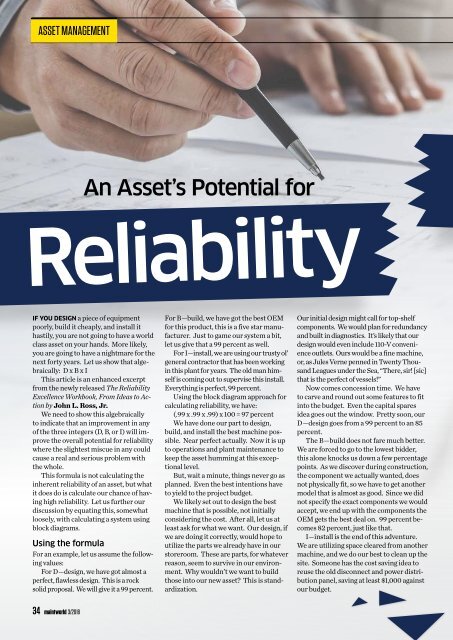Maintworld 3/2018
Are You Overlooking a Significant Source of Savings? // Advantages of broadband ultrasonic analysis // Are you in the “circle of despair”? // Future of work
Are You Overlooking a Significant Source
of Savings? // Advantages of broadband ultrasonic analysis // Are you in the “circle of despair”? // Future of work
Create successful ePaper yourself
Turn your PDF publications into a flip-book with our unique Google optimized e-Paper software.
asset management<br />
An Asset’s Potential for<br />
Reliability<br />
If you design a piece of equipment<br />
poorly, build it cheaply, and install it<br />
hastily, you are not going to have a world<br />
class asset on your hands. More likely,<br />
you are going to have a nightmare for the<br />
next forty years. Let us show that algebraically:<br />
D x B x I<br />
This article is an enhanced excerpt<br />
from the newly released The Reliability<br />
Excellence Workbook, From Ideas to Action<br />
by John L. Ross, Jr.<br />
We need to show this algebraically<br />
to indicate that an improvement in any<br />
of the three integers (D, B, or I) will improve<br />
the overall potential for reliability<br />
where the slightest miscue in any could<br />
cause a real and serious problem with<br />
the whole.<br />
This formula is not calculating the<br />
inherent reliability of an asset, but what<br />
it does do is calculate our chance of having<br />
high reliability. Let us further our<br />
discussion by equating this, somewhat<br />
loosely, with calculating a system using<br />
block diagrams.<br />
Using the formula<br />
For an example, let us assume the following<br />
values:<br />
For D—design, we have got almost a<br />
perfect, flawless design. This is a rock<br />
solid proposal. We will give it a 99 percent.<br />
For B—build, we have got the best OEM<br />
for this product, this is a five star manufacturer.<br />
Just to game our system a bit,<br />
let us give that a 99 percent as well.<br />
For I—install, we are using our trusty ol’<br />
general contractor that has been working<br />
in this plant for years. The old man himself<br />
is coming out to supervise this install.<br />
Everything is perfect, 99 percent.<br />
Using the block diagram approach for<br />
calculating reliability, we have:<br />
(.99 x .99 x .99) x 100 = 97 percent<br />
We have done our part to design,<br />
build, and install the best machine possible.<br />
Near perfect actually. Now it is up<br />
to operations and plant maintenance to<br />
keep the asset humming at this exceptional<br />
level.<br />
But, wait a minute, things never go as<br />
planned. Even the best intentions have<br />
to yield to the project budget.<br />
We likely set out to design the best<br />
machine that is possible, not initially<br />
considering the cost. After all, let us at<br />
least ask for what we want. Our design, if<br />
we are doing it correctly, would hope to<br />
utilize the parts we already have in our<br />
storeroom. These are parts, for whatever<br />
reason, seem to survive in our environment.<br />
Why wouldn’t we want to build<br />
those into our new asset? This is standardization.<br />
Our initial design might call for top-shelf<br />
components. We would plan for redundancy<br />
and built in diagnostics. It’s likely that our<br />
design would even include 110-V convenience<br />
outlets. Ours would be a fine machine,<br />
or, as Jules Verne penned in Twenty Thousand<br />
Leagues under the Sea, “There, sir! [sic]<br />
that is the perfect of vessels!”<br />
Now comes concession time. We have<br />
to carve and round out some features to fit<br />
into the budget. Even the capital spares<br />
idea goes out the window. Pretty soon, our<br />
D—design goes from a 99 percent to an 85<br />
percent.<br />
The B—build does not fare much better.<br />
We are forced to go to the lowest bidder,<br />
this alone knocks us down a few percentage<br />
points. As we discover during construction,<br />
the component we actually wanted, does<br />
not physically fit, so we have to get another<br />
model that is almost as good. Since we did<br />
not specify the exact components we would<br />
accept, we end up with the components the<br />
OEM gets the best deal on. 99 percent becomes<br />
82 percent, just like that.<br />
I—install is the end of this adventure.<br />
We are utilizing space cleared from another<br />
machine, and we do our best to clean up the<br />
site. Someone has the cost saving idea to<br />
reuse the old disconnect and power distribution<br />
panel, saving at least $1,000 against<br />
our budget.<br />
34 maintworld 3/<strong>2018</strong>

















